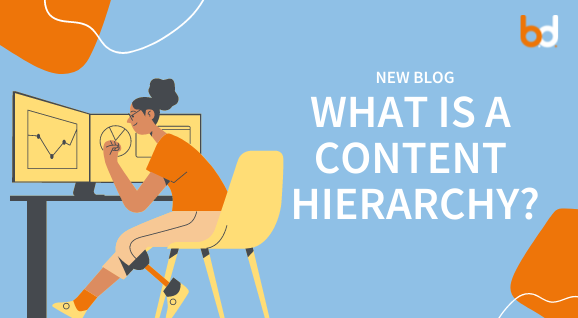
Content hierarchy is the process of arranging your web page’s content to emphasise the most important information. The basic maxim of a content hierarchy is to put the crucial information at the top and the least important information at the bottom of the page. To ensure your content is communicated effectively you need your design to follow a results-driven strategy, which is where following the content hierarchy comes in.
Whatever the type of content on your web page, you need it to have a clear purpose. It needs to be driven to provide a positive user experience, lead to action, and reflect the design of your website. With the strategic ordering of information, marketers can ensure their web page’s visitors find the content they need. For example, look at this blog post, we’ve put a description of what content hierarchy is right at the top of the page as we know it’s the most important information that you want to know.
Why Is Content Hierarchy Important In Digital Marketing?
Implementing an effective content hierarchy strategy keeps users engaged on your page for longer. While it varies across industries, in general, the average bounce rate for a website is 43% on desktop, 45% on tablet, and 51% on mobile. In today’s world, people want to see the information they clicked for on a web page straight away. Strategically arranging your content to place the key information at the top reduces the risk of users bouncing, improves the user experience, and makes it more likely they will continue to interact with the website.
The way many users consume content is by scanning. Sometimes they’ll quickly read the first few paragraphs to see if it’s worth their time or maybe users will only read the headings. Either way, if users don’t see what they’re looking for there will be one outcome: bouncing off the site. Using an effective content hierarchy gives you the best chance of retaining visitors and achieving your goals. When your content and design elements are ordered by importance, by only reading the first paragraph or even sentence, users discover the information they wanted.
Does An Effective Content Hierarchy Increase Conversion Rates?
Content should work to help you achieve your goals as a marketer and, most importantly, the goals of your site’s users. For an e-commerce website, their goal will be to sell products. If a user clicks through to one of their product pages, their goal will be to make a purchase. An effective content hierarchy arranges the design elements and words so it’s simple for the user to buy the product.
For blog posts, whether an effective content hierarchy increases conversion rates or not is more subtle. When they click through to a blog post, users are looking to learn something useful (hopefully, like you’re doing now), so the content shouldn’t be selling them a product or service. Align your goals as a marketer with the goals of your web page’s users, this way you both win.
The right content hierarchy strategy keeps users on the page engaging with content for longer. If the web page captures the user’s attention and helps them discover the information they’re looking for, this builds trust between your site and the prospect. When someone thinks of your website as a reliable source of information they’re more likely to purchase from you in the future.
How Do You Establish & Implement A Content Hierarchy?
Put yourself in the shoes of your target audience. Ask why they’re clicking through to the web page. The answer to this question is what the most important information is. However, the content hierarchy isn’t only one sentence or paragraph, it needs to cover an entire topic and how it flows together.
Use keyword research to learn the background of a topic. This gives you clear guidance on what is relevant information to include as part of the content. Exploring suggested searches also help establish the most effective order of information as you gain insight into the different questions people are asking.
Once you’ve established the most important information to emphasise, you need to include an effective call to action. Decide on the CTA you want to include. It doesn’t have to be linked directly to a conversion, but rather a goal you have. Is it to increase sign-ups to a newsletter? Encourage the user to click through to a product page? Fill in an enquiry form? Include a relevant CTA where users will see it, but not at the expense of any information as this will be the most important thing to the user.
Incorporate A Strong Visual Hierarchy As Well
The main focus of an effective content hierarchy is the writing. However, a web page is much more than the words on the page. The images you use, colour scheme, and much more all contribute to a positive user experience. Visual hierarchy arranges the design elements on a web page based on their relevance and importance.
Bright Design Content Marketing
At Bright Design, our team are experts at optimising content to achieve sustainable growth and results for our client partners. We develop bespoke content marketing approaches based on your business’s goals, target market, and requirements. Discover a content marketing strategy that generates tangible results, get in touch with our team today.

Leave a Reply